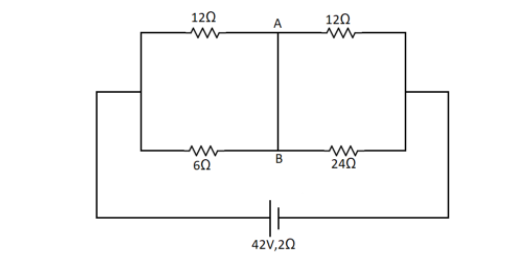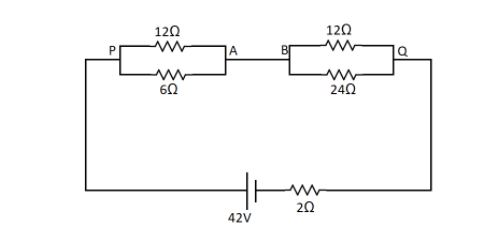
Find the current in wire AB

Answer
219k+ views
Hint: The wire AB in between connects all the 4 resistances. So by drawing the circuit in a simpler way, we can find the equivalent resistance. Then we can calculate the current being drawn from the cell using the emf of the call. This will be the current in the wire AB.
Formula Used In this solution, we are going to use the following formula,
${R_{eq}} = {R_1} + {R_2} + {R_3} + ....$ where ${R_{eq}}$ is the equivalent resistance when the resistances are placed in series.
And $\dfrac{1}{{{R_{eq}}}} = \dfrac{1}{{{R_1}}} + \dfrac{1}{{{R_2}}} + \dfrac{1}{{{R_3}}} + ....$ where ${R_{eq}}$ is the equivalent resistance when the resistances are placed in a parallel circuit.
$V = IR$ where $V$ is the emf of the cell, $I$ is the current in the wires and $R$ is the equivalent resistance.
Complete Step by Step Solution
To find the current in the wire AB we need to first redraw the circuit in a more simple way. Here the points A and B are the same point joined by a wire. So we can draw the circuit as,

From this circuit we can see that there are 2 parallel circuits consisting of 2 resistances each.
Let us first find the equivalent resistance between the points P and Q. The formula for parallel combination is
$\dfrac{1}{{{R_{eq}}}} = \dfrac{1}{{{R_1}}} + \dfrac{1}{{{R_2}}} + \dfrac{1}{{{R_3}}} + ....$
Here we have ${R_1} = 12\Omega $ and ${R_2} = 6\Omega $
So substituting we get,
$\dfrac{1}{{{R_{eq1}}}} = \dfrac{1}{{12}} + \dfrac{1}{6}$
Taking LCM as 12
$\dfrac{1}{{{R_{eq1}}}} = \dfrac{{1 + 2}}{{12}}$
So by taking the reciprocal we get,
${R_{eq1}} = \dfrac{{12}}{3} = 4\Omega $
Similarly, between the points B and Q we have 2 resistances in parallel combination. So again here ${R_1} = 12\Omega $ and ${R_2} = 24\Omega $
Substituting we get,
$\dfrac{1}{{{R_{eq2}}}} = \dfrac{1}{{12}} + \dfrac{1}{{24}}$
Taking LCM as 24,
$\dfrac{1}{{{R_{eq2}}}} = \dfrac{{2 + 1}}{{24}}$
Taking the reciprocal we get,
${R_{eq2}} = \dfrac{{24}}{3} = 8\Omega $
Now the resistance ${R_{eq1}}$, ${R_{eq2}}$ and the internal resistance of the battery are in series in the circuit. So we use the formula for series combination given by,
${R_{eq}} = {R_1} + {R_2} + {R_3} + ....$
Here ${R_1} = {R_{eq1}} = 4\Omega $, ${R_2} = {R_{eq2}} = 8\Omega $ and ${R_3} = 2\Omega $
So we get,
${R_{eq}} = 4 + 8 + 2$
Therefore, we get the equivalent resistance as,
${R_{eq}} = 14\Omega $
Now it is given that the battery has an emf of $V = 42V$
So from the Ohm’s law $V = IR$, we can get the current as,
$I = \dfrac{V}{{{\operatorname{R} _{eq}}}}$
Substituting we get,
$I = \dfrac{{42}}{{14}} = 3A$
This is the whole current that is in the flowing through the wire. Now since between the points A and B the current doesn’t get divided, so the current in the wire AB will be $3A$.
Note: In the given circuit, when the two resistances are in series condition then the current that flows in them both is the same whereas when the resistances are in parallel, the potential difference is the same across the resistances but the current varies. So the current in the 2 wires between P and A are different and depends on the magnitude of the resistance.
Formula Used In this solution, we are going to use the following formula,
${R_{eq}} = {R_1} + {R_2} + {R_3} + ....$ where ${R_{eq}}$ is the equivalent resistance when the resistances are placed in series.
And $\dfrac{1}{{{R_{eq}}}} = \dfrac{1}{{{R_1}}} + \dfrac{1}{{{R_2}}} + \dfrac{1}{{{R_3}}} + ....$ where ${R_{eq}}$ is the equivalent resistance when the resistances are placed in a parallel circuit.
$V = IR$ where $V$ is the emf of the cell, $I$ is the current in the wires and $R$ is the equivalent resistance.
Complete Step by Step Solution
To find the current in the wire AB we need to first redraw the circuit in a more simple way. Here the points A and B are the same point joined by a wire. So we can draw the circuit as,

From this circuit we can see that there are 2 parallel circuits consisting of 2 resistances each.
Let us first find the equivalent resistance between the points P and Q. The formula for parallel combination is
$\dfrac{1}{{{R_{eq}}}} = \dfrac{1}{{{R_1}}} + \dfrac{1}{{{R_2}}} + \dfrac{1}{{{R_3}}} + ....$
Here we have ${R_1} = 12\Omega $ and ${R_2} = 6\Omega $
So substituting we get,
$\dfrac{1}{{{R_{eq1}}}} = \dfrac{1}{{12}} + \dfrac{1}{6}$
Taking LCM as 12
$\dfrac{1}{{{R_{eq1}}}} = \dfrac{{1 + 2}}{{12}}$
So by taking the reciprocal we get,
${R_{eq1}} = \dfrac{{12}}{3} = 4\Omega $
Similarly, between the points B and Q we have 2 resistances in parallel combination. So again here ${R_1} = 12\Omega $ and ${R_2} = 24\Omega $
Substituting we get,
$\dfrac{1}{{{R_{eq2}}}} = \dfrac{1}{{12}} + \dfrac{1}{{24}}$
Taking LCM as 24,
$\dfrac{1}{{{R_{eq2}}}} = \dfrac{{2 + 1}}{{24}}$
Taking the reciprocal we get,
${R_{eq2}} = \dfrac{{24}}{3} = 8\Omega $
Now the resistance ${R_{eq1}}$, ${R_{eq2}}$ and the internal resistance of the battery are in series in the circuit. So we use the formula for series combination given by,
${R_{eq}} = {R_1} + {R_2} + {R_3} + ....$
Here ${R_1} = {R_{eq1}} = 4\Omega $, ${R_2} = {R_{eq2}} = 8\Omega $ and ${R_3} = 2\Omega $
So we get,
${R_{eq}} = 4 + 8 + 2$
Therefore, we get the equivalent resistance as,
${R_{eq}} = 14\Omega $
Now it is given that the battery has an emf of $V = 42V$
So from the Ohm’s law $V = IR$, we can get the current as,
$I = \dfrac{V}{{{\operatorname{R} _{eq}}}}$
Substituting we get,
$I = \dfrac{{42}}{{14}} = 3A$
This is the whole current that is in the flowing through the wire. Now since between the points A and B the current doesn’t get divided, so the current in the wire AB will be $3A$.
Note: In the given circuit, when the two resistances are in series condition then the current that flows in them both is the same whereas when the resistances are in parallel, the potential difference is the same across the resistances but the current varies. So the current in the 2 wires between P and A are different and depends on the magnitude of the resistance.
Recently Updated Pages
Two discs which are rotating about their respective class 11 physics JEE_Main

A ladder rests against a frictionless vertical wall class 11 physics JEE_Main

Two simple pendulums of lengths 1 m and 16 m respectively class 11 physics JEE_Main

The slopes of isothermal and adiabatic curves are related class 11 physics JEE_Main

A trolly falling freely on an inclined plane as shown class 11 physics JEE_Main

The masses M1 and M2M2 M1 are released from rest Using class 11 physics JEE_Main

Trending doubts
JEE Main 2026: Application Form Open, Exam Dates, Syllabus, Eligibility & Question Papers

Understanding Uniform Acceleration in Physics

Derivation of Equation of Trajectory Explained for Students

Hybridisation in Chemistry – Concept, Types & Applications

Understanding the Angle of Deviation in a Prism

Understanding Collisions: Types and Examples for Students

Other Pages
JEE Advanced Marks vs Ranks 2025: Understanding Category-wise Qualifying Marks and Previous Year Cut-offs

Units And Measurements Class 11 Physics Chapter 1 CBSE Notes - 2025-26

NCERT Solutions For Class 11 Physics Chapter 8 Mechanical Properties Of Solids

Motion in a Straight Line Class 11 Physics Chapter 2 CBSE Notes - 2025-26

NCERT Solutions for Class 11 Physics Chapter 7 Gravitation 2025-26

Understanding Atomic Structure for Beginners




